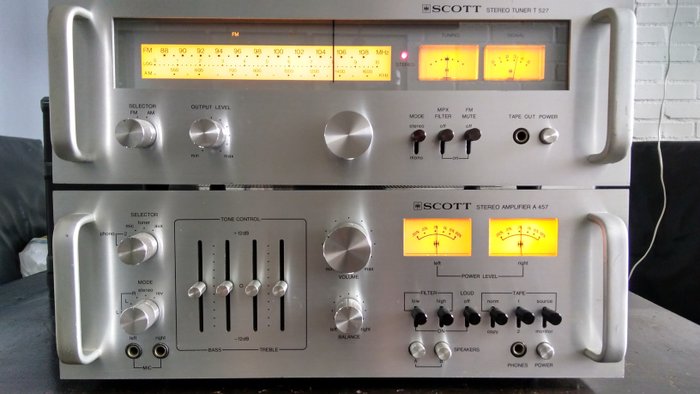

I did not immediately check the balance pots for the grid bias adjustments on the output tubes, a mistake on my part. However, the voltage from the bias supply with the silicon rectifier in place was spot-on. I replaced the little selenium bridge with a silicon bridge expecting to have to reduce its output to match the 48 volts. It wasn't producing even half that which was obvious because the four 12AX7 tubes did not show a proper filament glow. That means the supply must deliver about 48 volts output after the filter capacitors and resistors.
#Scott stereo master manual#
The manual and schematic do not show the voltage output from that bias rectifier, but it supplies the DC filament voltage for four 12AX7 series-connected preamp tubes.

#Scott stereo master full#
The bias supply in the Scott 340, like similar sets, is by way of a small full wave selenium bridge rectifier. Proper negative grid bias voltage is vital in such sets. The cathodes for all the 7591A output tubes are directly grounded. That is an important step in this set and many other high power audio tube sets using a fixed bias supply as opposed to cathode bias. I gave it a thorough cleaning with waterless hand cleaner and old toothbrushes and rags.Īfter safety checks such as checking the fuse for proper size and for any line to chassis leakage which was not a problem in this set, I often do an initial power-up without the high voltage rectifier tubes to check the AC voltages from the power transformer and proper current draw for just the filaments. Dirt is typical for a set that has not been used in a long time. September 1962 ad in 'High Fidelity' magazineĮxcept for an accumulation of dust and dirt, the set was in good cosmetic condition including the wooden case. The set is now often identified as a Scott 340A to distinguish it from the very different 340B. The optional case was an additional cost. Advertised price for the 340 was $379.95. It has a total of 20 tubes including four 7591A output tubes and a pair of 5AR4/GZ-34 rectifiers. The set essentially combines the Scott 350 FM multiplex tuner with the Scott 299C amplifier. Introduced in April 1962, the HH Scott 340 "Stereomaster" tuner-amplifier is rated at 27 watts per channel for a total of 54 watts RMS (advertised at 60 watts output and later 70 watts). Scott 340 "Stereomaster" tuner-amplifier without its walnut case Only then can you start on the rest of the restoration.Įlectrolytics, Waxed and PIO caps and check resistors for wandering values.HH Scott 340 Stereomaster tuner-amplifier HH Scott 340 "Stereomaster" tuner-amplifier Only once you've got the heater voltage back down to 12.6V x 4 can you plug the valves back in knowing that their heaters will be safe. With all the caps in place you might need to tweek R209 as the voltage may rise slightly.

C207 - 210 can then be replaced with caps with similar ratings to those originally used as long as their rated voltages are higher than measured. You might opt to spread the volt drop across the other two resistors, that is up to you. Measuring the voltage across R209 you can then calculate a new value for R209 to bring the voltage into spec.

Now you will need to simulate the heater load ie 330R 10W resistor.
#Scott stereo master series#
Now we know that the heater load is 4 x 12AX7, the heaters are wired in series so they will draw 4 x 12.6V at 150mA. 100uF/100V will probably be the modern available cap. Now replace C210 with 100uF with a voltage rating above that measured. This will be higher than the -70V that the SRs gave. Measure the new heater voltage at the anode of D201. Temporarily fit a 160V electrolytic in the place of C210, it only needs to be 10uF or something small. Remove C207 - 210 as we are not sure of their condition nor of the new -ve heater voltage. All the heaters will be safe as they will be in your spares box. The HT will remain safely dead as V201 will be missing. I would recommend pulling ALL the valves and powering on. If you are replacing the selenium rectifiers (recommended) you will have to play with the heater circuit.


 0 kommentar(er)
0 kommentar(er)
